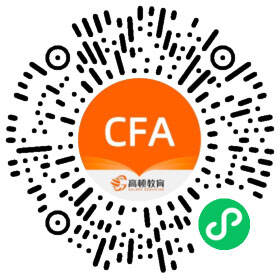
报考指南:2014年CFA考试备考指南
免费题库:2014年CFA免费题库
考前冲刺:CFA备考秘籍
高清网课:CFA考试网络课程



1、凡本网站注明“来源高顿教育”或“来源高顿网校”或“来源高顿”,的所有作品,均为本网站合法拥有版权的作品,未经本网站授权,任何媒体、网站、个人不得转载、链接、转帖或以其他方式使用。
2、经本网站合法授权的,应在授权范围内使用,且使用时必须注明“来源高顿网校”或“来源高顿”,并不得对作品中出现的“高顿”字样进行删减、替换等。违反上述声明者,本网站将依法追究其法律责任。
3、本网站的部分资料转载自互联网,均尽力标明作者和出处。本网站转载的目的在于传递更多信息,并不意味着赞同其观点或证实其描述,本网站不对其真实性负责。
4、如您认为本网站刊载作品涉及版权等问题,请与本网站联系(邮箱fawu@gaodun.com,电话:021-31587497),本网站核实确认后会尽快予以处理。
金融分析师是一种专业的金融人才,他们的主要职责是通过对金融市场和经济趋势的研究和分析,为企业和个人提供专业的意见和建议。他们的工作内容包...
2023-05-18CFA(CharteredFinancialAnalyst)它是一种专业的金融认证,可以证明一个人在金融分析、投资和管理方面的知识和技能。如果你想成为一名金融分析师,CFA证书可...
2023-05-18在经济日益发展的时代,许多人逐渐开始了解了提升自我的重要性,今天小编就来好好跟大家讲讲关于高顿ESG课程情况,帮助您更深入了解ESG,下面请跟随...
2023-05-11假如你正在准备CFA考试,那么你必须知道这是一个艰巨的挑战。CFA考试不仅要求你具备深入的财务知识,还要求你具备优秀的时间管理能力和考试策略。本...
2023-05-18金融分析师在哪里工作,薪资待遇咋样?最近有小伙伴问道小编这个问题,在知道这个答案之前呢,我们需要先来了解一下什么是“金融分析师"下面请跟随...
2023-05-18CFA考试只能用英语吗?最近,很多学生都在咨询小编。今天,我们来谈谈为什么CFA考试只用英语。感兴趣的考生可以进来和你讨论。具体情况下面请跟随...
2023-05-18首先需要明确的是,CFA考试不是一个简单的考试,它涉及金融、经济、会计、投资、风险管理等诸多领域。因此,对于零基础的考生来说,准备考试需要足...
2023-05-18有可能通过CFA自学考试吗?这是很多想通过CFA资格认证的人关心的问题。CFA作为全球金融行业的国际认证考试,考试难度很大,要求考生有扎实的金融知识...
2023-05-18CFA考试全称是“”CharteredFinancialAnalyst“(即注册金融分析师或特许金融分析师)是由“股神”巴菲特的老师本杰明·格雷厄姆创办的英语金融投资专业资格证...
2023-05-18CFA证书几乎是金融界的高含金量证书。CFA不需要有金融背景就可以参加考试。这对很多想进入金融业的人来说是个好消息,但CFA不容易参加考试。毕竟是国...
2023-05-18为什么说随机模型更容易受管理人员主观判断的影响
老师,超定额废品损失是什么?
老师,题目说a是3阶矩阵有3各不同特征值,这能推出什么结论,和秩有怎样的关系呢,这里想不过来
叉车的最低折旧年限是多少?
销售部门上缴1万元,未存入银行 。这个不需要在对账单里+1吗
为什么说随机模型更容易受管理人员主观判断的影响
老师,超定额废品损失是什么?
老师,题目说a是3阶矩阵有3各不同特征值,这能推出什么结论,和秩有怎样的关系呢,这里想不过来
叉车的最低折旧年限是多少?
销售部门上缴1万元,未存入银行 。这个不需要在对账单里+1吗
CFA和CPA是两个非常重要的金融行业证书,它们在金融领域都有着很高的声誉和影响力。但是,很多人并不清楚这两个证书的区别,以及哪个证书的含金量更高。本文将探讨这个问题,并为您提供一些有用的信息来帮助您做出正确的决策。今天candy学姐就来好好跟大家讲讲这个话题,一起来看看吧~...
2023-05-19职业资格证书是金融业职业发展中不可缺少的一环。而且在投资领域,CIIA(国际注册投资分析师)和CFA(特许金融分析师)是两个备受关注的职业证书。那么,哪个职业证书含金量更高呢?本文将讨论这个问题。具体情况下面请跟随candy学姐一起来看看吧~...
2023-05-18金融业一直是人们关注的焦点,在这个行业,高级金融分析师是一个备受追捧的职位。那么,高级金融分析师的年薪是多少呢?今天学姐就来好好跟大家讲讲这个事情,下面请跟随candy学姐一起来看看吧~...
2023-05-18在CFA(Chartered Financial Analyst)考试中,计算器是一项非常重要的工具,能够帮助考生在解决各种复杂的金融和投资计算问题时提高效率。以下是CFA计算器使用方法的简要教程,帮助您更好地掌握这一工具。今天学姐就来好好跟大家讲讲关于cfa计算器使用操作方法这件事儿,一起来看看吧~...
2023-05-18金融分析师是一种专业的金融人才,他们的主要职责是通过对金融市场和经济趋势的研究和分析,为企业和个人提供专业的意见和建议。他们的工作内容包括收集、整理和分析各种金融数据,进行投资和风险评估,制定投资策略等。今天小编就来好好跟大家一起聊聊关于CFA价值这个话题,下面请跟随candy学.........
2023-05-18考生们在备考特许金融分析师CFA考试时,掌握一些技巧,往往会有意想不到的结果。以下是小编为大家整理的关于cfa考试复习的方法与技巧,欢迎大家参考学习,希望对大家有所帮助!想了解更多相关信息,请继续关注我们!...
2023-02-20什么是CFA?cfa考试需要考哪些科目?CFA证书是金融领域比较受欢迎的,报考条件门槛低,每年的报考人数居高不下。一旦你获得了特许金融分析师CFA证书,就意味着你踏入了金融行业的大门,可以从事与金融行业相关的工作。...
2023-02-20特许金融分析师CFA考位怎么预约?小编提醒各位CFA考生:准备参加cfa考试的同学在安排自己的考试计划时,可以先查询一下想要参加考试的窗口内还有哪些考位可以预约,一定要在考位截止时间前完成报名。以便提前安排住宿,顺利参加考试!...
2023-02-162023年8月CFA考试报名如何缴费?2023年CFA报名可以网上缴费吗?CFA缴费方式有哪些?正在报名2023年8月CFA考试的考生一定要按时缴费!今天,小编为各位同学整理了CFA五种缴费方式的相关信息,希望能帮助到同学们。...
2023-02-16最近有不少准备在2023年8月报考CFA考试的小伙伴向小编咨询如何预约考位的问题。因此,小编为大家整理了CFA一级考试查询考场具体位置及考位预约的具体步骤,想在2023年8月报考CFA一级考试的小伙伴们可以参考一下,尽快预约考位!...
2023-02-16现在很多在职人员因为社会大环境的影响而选择报考CFA。目前很多上班族,由于无法平衡学习和工作的时间,所以如何高效备考CFA?是很多朋友都比较关注的问题。今天,就和小编一起来看看高效备考CFA的方法吧。...
2023-02-15一般来说,在职考生备考CFA一级的时间没有那么宽裕,很多时候都是碎片化学习,所以如何平衡工作和学习就成为了大家共同的问题。那么在职如何备考CFA一级?把握CFA一级考试的复习节奏呢?CFA一级备考方法请看下文,希望对小伙伴们有所帮助。...
2023-02-15很多人都已经开始要备考2023年CFA特许金融分析师考试了。那么大家清楚2023年CFA各个考季的时间安排吗!以下是小编整理的2023年CFA各个考季时间安排表,希望可以提供给大家进行参考和借鉴,提前合理的分配CFA备考时间。...
2023-02-15CFA一级机考的时间是有限的,所以考考生需要掌握一些适合自己的基本答题技巧,既要提高做题效率,又要提高做题准确率。为了让考生在考试中充分发挥自己的实力,小编为大家总结出如下内容,让大家提前了解CFA一级考试的选择题题型。...
2023-02-15报考CFA考试实现就业的同学不在少数。事实上,无论是职场人士还是大学生报考CFA,很多人都是奔着就业去的,希望在提升专业能力的同时,还能获得更多的选择。那么,非经济学专业学生考cfa有用吗?今天,小编来给大家介绍一下。...
2023-02-15